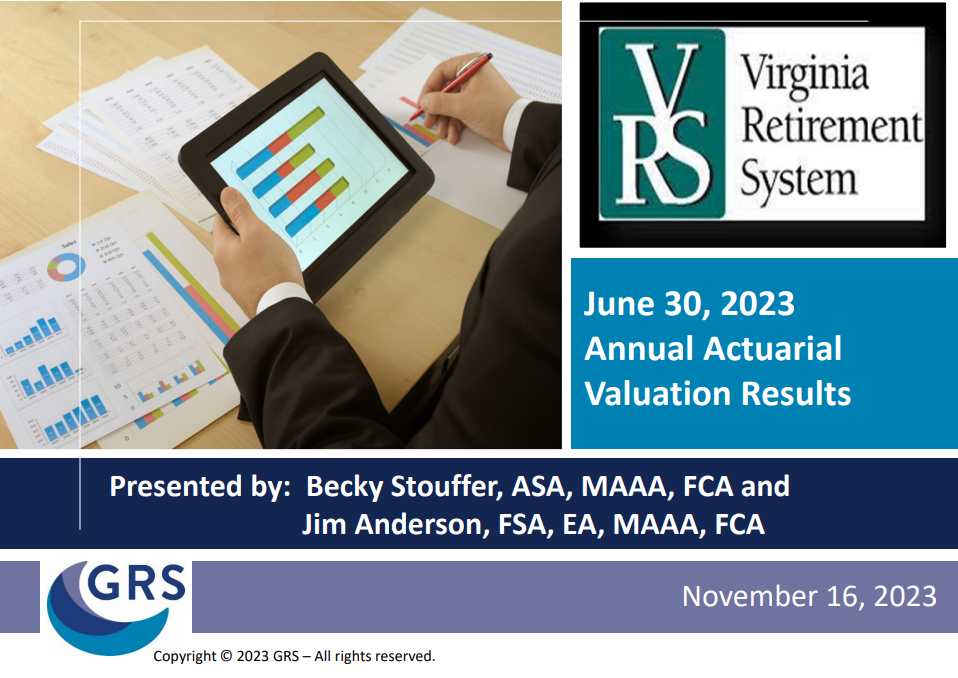At its November 16 meeting, the VRS Board of Trustees approved FY 2025-2026 employer contribution rates for participating political subdivisions. Gabriel, Roeder, Smith & Company (GRS), the VRS plan actuary, highlighted factors that influenced contribution rates, based on data from the June 30, 2023, valuations. As previously reported, odd year valuations determine employer contributions for the coming biennium.
According to VRS, about two-thirds of the local pension plans (401 employers total) are at least 90% funded on an actuarial value of assets basis. Overall, the number of participants in political subdivision pension plans increased 4% from the prior year and the average salary of political subdivision employees increased 6.2% from the prior year. Also, retirees received near-maximum or maximum cost-of-living adjustments in 2022 and 2023. The aggregate funded status for all political subdivision plans was 88% as of June 30, 2023, on an actuarial value of assets basis, up from 87% in the last rate-setting valuation in 2021.
Political subdivision plans contribution rates are calculated based on the assets and liabilities of each individual participating employer, the benefit offerings (enhanced hazardous duty coverage, for example), the demographics of the covered employees and the current funded level of that employer’s plan.
Overall, nearly 70% of employers will see an increase in their pension rate of less than 1% based on 2023 valuations. The average actuarially determined employer contribution rate for employers who don’t offer enhanced hazardous duty benefits is 5.58%, while the average rate for employers who do offer enhanced hazardous duty benefits is 14.34%.
While the funded status and contribution rates remain stable, plan unfunded liabilities remain. The VRS board approved a funding policy change to reset the total unfunded accrued liability to be amortized over 20 years. This means a slight increase in contribution rates in the short term; however, the action results in getting money into the fund more quickly to be invested sooner, leveling out the amortization payments in later years, which, in general, should generate savings over time. However, the impact of this change on political subdivisions will vary based on individual plan assets and liabilities.
In addition, the board approved FY 2025-2026 contribution rates for the health insurance credit for participating political subdivisions, the Virginia Local Disability Program (VLDP) and the Line of Duty Act (LODA) Fund.
Next quarter, VRS will send actuarial reports to each VRS-participating employer that will include the retirement plan contribution rate, along with rates for the health insurance credit, if applicable. You can view the actuary’s presentation to the board for additional information.
The VRS board also certified the FY 2025-2026 contribution rate for the Line of Duty Act Fund. Pending approval from the General Assembly, participating employers will pay $995 per full-time employee, an increase from $830 this fiscal year.
Beginning July 1, 2024, the board-certified employer contribution rates for the retirement plans will apply only to the defined benefit portion of the benefits. As previously reported, legislation passed in 2022, where employers will manage payroll withholding for the defined contribution component independently from the defined benefit component. A delayed effective date of July 1, 2024 allowed time for employers to update payroll systems and to make other changes. Previously, the board-certified employer rates included an estimate of the defined contributions for Hybrid Retirement Plan members. VRS staff will be contacting VACo soon regarding this change and providing further information.
More information the VRS Board of Trustees and the November 16th meeting may be viewed here and here respectively.
VACo Contact: Jeremy R. Bennett

